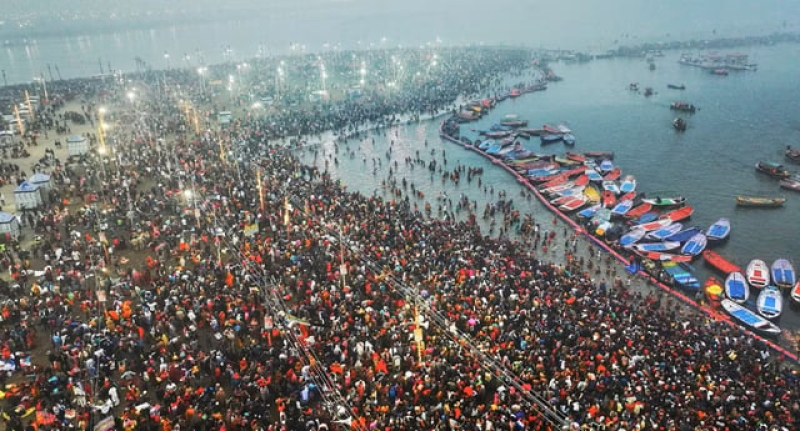- Stock market: DSE fails to sustain early gains, CSE extends rally |
- Illegal arms, disinformation pose major challenges to BD polls: Officials |
- BNP senses ‘dangerous conspiracy’ against democratic transition |
- CEC Vows Credible Election to End Stigma |
- High-level meeting reviews country’s economic progress |
India Deploys AI to Prevent Stampedes at Kumbh Mela

In a bid to address India's longstanding challenges with crowd management at large-scale religious events, organisers of the Kumbh Mela are employing artificial intelligence to prevent dangerous stampedes at the world’s largest human gathering.
The festival, a centuries-old Hindu tradition involving ritual bathing, is expected to attract up to 400 million pilgrims over its six-week duration, which began Monday. The Kumbh Mela, known for its vast crowds, has witnessed deadly stampedes in the past, making crowd control a critical concern.
"We want everyone to leave happy, having fulfilled their spiritual duties," said Amit Kumar, a senior police officer overseeing the festival’s tech operations. "AI is helping us prevent overcrowding in sensitive areas."
Historically, the Kumbh Mela has seen devastating crowd-related disasters, including one of the deadliest in 1954, when over 400 people were killed in a stampede. In 2013, 36 lives were lost in a similar tragedy. However, this year, authorities are optimistic that advanced technology will reduce such risks.
The authorities have implemented a sophisticated crowd monitoring system, featuring over 300 cameras strategically placed around the festival site and along major access routes. In addition to cameras mounted on poles, a fleet of drones patrols the area. These cameras feed data into a command center located near the festival’s spiritual heart, where police officers and technicians continuously monitor the situation.
"We can observe the entire festival from here," Kumar said, pointing to a glass-panelled command room. "Some areas are so crowded that we can’t count bodies directly, so we rely on head and torso counts."
The AI system processes the camera feeds and uses algorithms to estimate crowd size, cross-referencing the data with information from local transport networks. If any area reaches a critical density, an alert is triggered, warning officials to take action before a dangerous crush develops.
"This is a game-changer for managing the festival’s size and scale," Kumar added. "We track crowd movement, density at key points, and use predictive modeling to identify potential trouble spots."
The Kumbh Mela, rooted in Hindu mythology, celebrates the mythic battle for the nectar of immortality. This year’s festival, with an expected turnout exceeding the combined populations of the United States and Canada, is described as a temporary "megacity" for the duration of the event. On the first day alone, about six million devotees took part in the ritual bath, according to estimates.
Given the sheer size of the event, some degree of crowd congestion is inevitable. However, Kumar explained that the festival’s higher population density makes it more resilient to crowd pressures than similar events in other countries. "While Western standards may set a threshold of three people per square foot, we can safely handle far more in India," he said.
For many pilgrims, the presence of cameras and drones provides a sense of security. "The technology makes us feel safe," said Harshit Joshi, a 28-year-old automotive engineer who arrived for the festival’s opening day. "It’s reassuring to know that AI is working to keep us safe."
The use of AI at the Kumbh Mela marks a significant intersection of tradition and technology, as organisers seek to ensure that millions can gather safely to celebrate their faith. Uttar Pradesh Chief Minister Yogi Adityanath has called the event “a confluence of faith and modernity,” highlighting the transformative potential of technology in managing large crowds.

